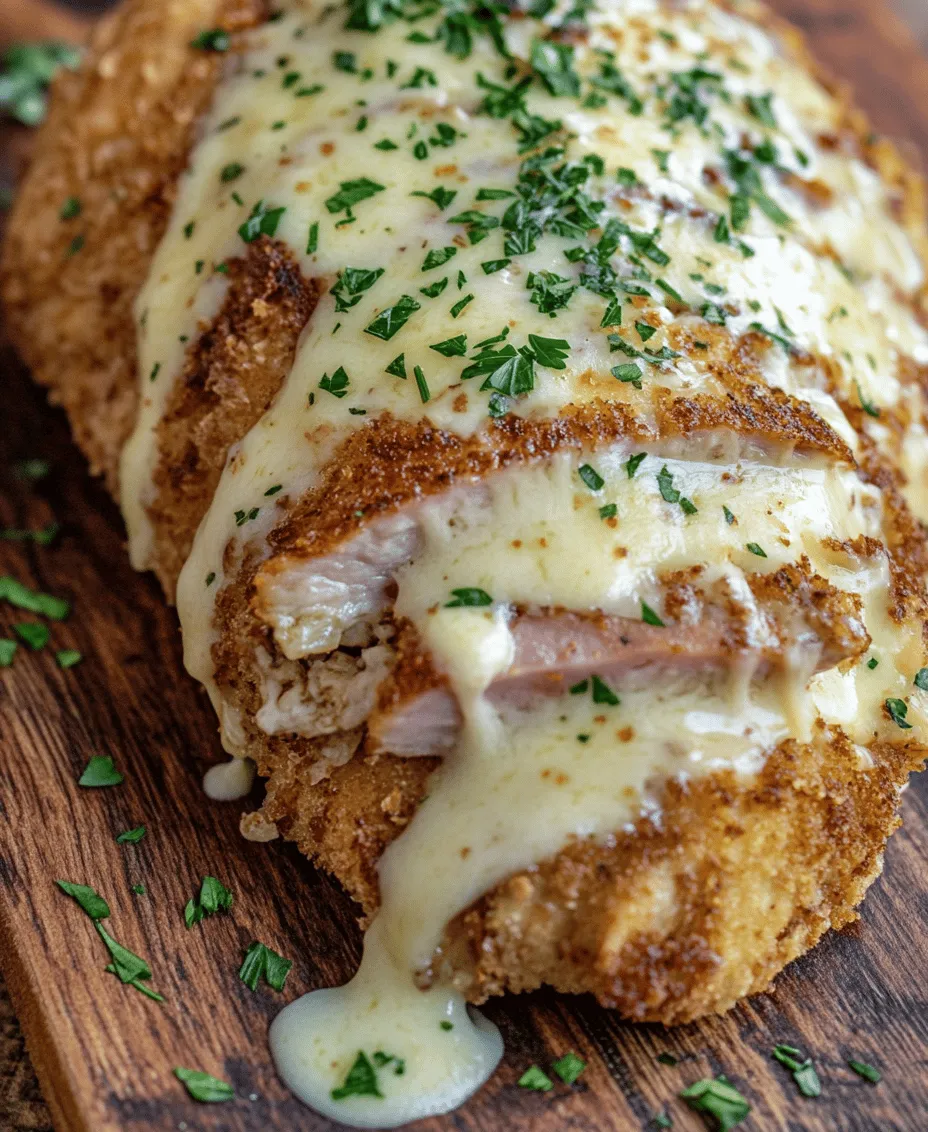Introduction
Chicken Cordon Bleu is a timeless classic that has graced dinner tables around the world, embodying the very essence of comfort food. This dish marries the tender, juicy qualities of chicken breast with savory fillings of ham and Swiss cheese, all enveloped in a crispy, golden-brown breading. The contrast of textures—the crunchy exterior against the tender interior—alongside the rich, creamy Swiss cheese sauce, makes for a delightful dining experience that is as visually appealing as it is delicious.
What truly sets homemade Chicken Cordon Bleu apart from its restaurant counterpart is not just the quality of ingredients but also the personal touch that each cook brings to the dish. Whether it’s for a family dinner, a romantic date night, or a special occasion, this dish consistently impresses and satisfies. The joy of preparing this culinary masterpiece in your own kitchen allows you to control the flavors and quality, ensuring that each bite is a testament to your culinary skills.
Understanding Chicken Cordon Bleu
The roots of Chicken Cordon Bleu can be traced back to Europe, with variations existing in various cuisines, notably French and Swiss. The term “Cordon Bleu” translates to “Blue Ribbon,” which historically signifies excellence in cooking. While the exact origins of the dish are a topic of debate, it is widely believed to have been popularized in the mid-20th century, quickly becoming a staple in American homes and restaurants.
The beauty of Chicken Cordon Bleu lies in its versatility. While the traditional preparation often features thinly sliced ham and Swiss cheese, modern adaptations have seen the incorporation of various types of meats—such as prosciutto or even turkey—and cheeses, ranging from mozzarella to gouda. The basic method of preparation remains relatively consistent, involving the rolling of the chicken and fillings, breading, and frying or baking until golden and crispy.
This dish is beloved across different cultures, not just for its flavor but also for its ability to bring people together. It’s a dish that can elevate an everyday meal into something special, showcasing both culinary technique and the joy of cooking.
Ingredients Breakdown
To create a delightful Chicken Cordon Bleu with a creamy Swiss cheese sauce, it’s essential to understand the significance of each ingredient involved in the recipe. Here’s a closer look at the key components that will bring this dish to life:
Boneless, Skinless Chicken Breasts
The foundation of any Chicken Cordon Bleu is, of course, the chicken itself. Boneless, skinless chicken breasts serve as the canvas for this dish, providing a lean protein that, when cooked properly, remains tender and juicy. It’s essential to select high-quality chicken to ensure the best flavors and textures.
Types of Ham
The choice of ham can significantly influence the flavor profile of your Chicken Cordon Bleu. Options like Black Forest ham, with its rich, smoky flavor, or a milder smoked ham can add depth to the dish. The saltiness of the ham complements the creaminess of the cheese, creating a harmonious balance of flavors.
Swiss Cheese
Swiss cheese is the traditional choice for this dish, prized for its superb melting qualities. The nutty and slightly sweet flavor of Swiss cheese enhances the overall taste of the chicken, making every bite deliciously creamy. For an added depth, consider using Gruyère cheese, which features a more robust flavor that pairs beautifully with the ham.
Breading Components
The breading is crucial for achieving that coveted crispy exterior. The combination of all-purpose flour, beaten eggs, and breadcrumbs works to create a crunchy coating that seals in the flavors of the chicken and filling. The breadcrumbs can be seasoned for extra flavor, contributing to the overall taste experience of the dish.
Seasonings
Simple seasonings like garlic powder and paprika not only enhance the flavor of the chicken but also add depth to the overall dish. Garlic powder lends a subtle warmth, while paprika contributes a mild smokiness and vibrant color, making the chicken visually appealing.
Ingredients for the Creamy Swiss Cheese Sauce
The creamy sauce is the crowning glory of Chicken Cordon Bleu, elevating the dish to new heights. Here’s a breakdown of the essential ingredients for the sauce:
– Butter and Flour: These two ingredients are the foundation of the roux, which thickens the sauce. Butter adds richness, while flour provides the necessary structure.
– Whole Milk: Using whole milk ensures that the sauce is creamy and luscious, creating a rich backdrop for the flavors of the cheese and seasonings.
– Dijon Mustard: This ingredient adds a tangy depth to the sauce, cutting through the richness and enhancing the overall flavor profile.
– Fresh Parsley: While optional, a sprinkle of fresh parsley adds a pop of color and freshness to the finished dish, making it visually appealing.
Preparation Steps Explained
Preparing the Chicken
The first step in crafting your Chicken Cordon Bleu is preparing the chicken breasts. Begin by placing each chicken breast between two sheets of plastic wrap or parchment paper. Using a meat mallet or rolling pin, pound the chicken to an even thickness of about half an inch. This step is crucial, as it allows for even cooking and ensures that the chicken remains tender and juicy.
Seasoning Tips: After pounding, season both sides of the chicken breasts with salt, pepper, garlic powder, and paprika. This will ensure that every layer of the dish is infused with flavor, making each bite delicious.
Assembling the Chicken Cordon Bleu
Now comes the fun part—assembling your Chicken Cordon Bleu! Lay out the prepared chicken breasts on a flat surface. On each breast, place a slice of ham followed by a generous slice of Swiss cheese. For a more decadent experience, feel free to double the cheese or add a second layer of ham.
Carefully fold the sides of the chicken over the filling, and then roll it up tightly from one end to the other. Secure the rolls with toothpicks or kitchen twine to keep the filling from spilling out during cooking. Once all the chicken is rolled and secured, you’re ready to move on to the breading process.
Breading the Chicken
Set up a breading station with three shallow dishes: one with flour, one with beaten eggs, and one with breadcrumbs. First, roll each chicken bundle in the flour, ensuring it is coated evenly. Next, dip it into the egg mixture, allowing any excess to drip off. Finally, coat the chicken in breadcrumbs, pressing gently to adhere.
This step is essential for achieving that crispy, golden exterior that is characteristic of Chicken Cordon Bleu. Once all the chicken pieces are breaded, they are ready for the next cooking stage.
Stay tuned for the next part of this article, where we will delve into the cooking methods, the preparation of the creamy Swiss cheese sauce, and tips to ensure your Chicken Cordon Bleu turns out perfectly every time.

Techniques for Rolling Chicken to Maintain Filling Integrity
Rolling chicken for Chicken Cordon Bleu may seem simple, but it requires a bit of finesse to ensure the filling stays intact during cooking. Start by placing your chicken breast between two pieces of plastic wrap or parchment paper. This not only protects the meat but also allows you to pound it evenly with a meat mallet or rolling pin until it’s about a quarter-inch thick. A uniform thickness ensures consistent cooking.
Once your chicken is flattened, lay your ham and Swiss cheese on one side of the breast, leaving about an inch of space from the edges. Carefully fold the edges over the filling, then start rolling from the filled side, tucking in the edges as you go to prevent any filling from escaping. Secure the roll tightly but not too tightly—this can cause the chicken to burst during cooking.
Discussion on Toothpicks and Alternatives for Securing Rolls
Toothpicks are a common choice for securing your chicken rolls, but they’re not your only option. If you prefer a less visible solution, kitchen twine is a great alternative. Simply tie the rolled chicken with twine at intervals to keep the filling in place. If you opt for toothpicks, be sure to remove them before serving, as they can be a choking hazard. Whichever method you choose, securing the rolls properly is crucial for maintaining the integrity of the dish.
Breading Techniques
Breading Chicken Cordon Bleu adds a delightful crunch that contrasts beautifully with the creamy filling. To set up an efficient breading station, arrange three shallow dishes in a row: one for flour, one for beaten eggs, and one for breadcrumbs.
1. Flour: Season the all-purpose flour with salt, pepper, and any other spices you prefer, such as paprika or garlic powder. This adds flavor to the chicken itself.
2. Egg Wash: In the second dish, beat a couple of eggs together. This will help the breadcrumbs adhere to the chicken.
3. Breadcrumbs: Use panko breadcrumbs for an extra crispy finish. You can season these with dried herbs like oregano or thyme for added flavor.
When breading your chicken rolls, first coat them in the seasoned flour, shaking off any excess. Next, dip them in the egg wash, ensuring they are fully coated, and finally roll them in the breadcrumbs, pressing gently to adhere. The key is to get an even coating, so don’t be shy about pressing the breadcrumbs onto the chicken.
Importance of Pressing Breadcrumbs for Adherence and Crunch
Pressing the breadcrumbs firmly onto the chicken is crucial for achieving a crispy texture. This technique ensures that the breadcrumbs stick during cooking, creating a delicious crust that contrasts with the tender chicken and melty cheese inside. If your breadcrumbs seem to be falling off during cooking, it may be due to insufficient pressure when coating or not allowing the chicken to rest before frying. A brief resting period after breading helps the coating adhere better.
Cooking the Chicken
When it comes to cooking Chicken Cordon Bleu, you have two main options: skillet frying and oven baking. Each method has its pros and cons.
Skillet Frying: This method produces a beautifully golden-brown crust and a juicy interior due to the direct heat. Heat a generous amount of oil in a large skillet over medium-high heat. Once hot, gently place the breaded chicken rolls in the pan, being careful not to overcrowd them. Cook for about 4-5 minutes on each side until golden brown and cooked through. Keep in mind that frying can lead to a mess, and you’ll need to monitor the temperature closely.
Oven Baking: Baking is a healthier alternative that requires less oil. Preheat your oven to 375°F (190°C) and place the breaded chicken on a baking sheet lined with parchment paper. Bake for 25-30 minutes, or until the chicken is cooked through and the breading is golden. While this method is less hands-on, it may not yield the same crispy texture as frying.
Regardless of the cooking method, always check the internal temperature of the chicken. It should reach at least 165°F (75°C) to ensure it’s safe to eat and tender.
Creating the Creamy Swiss Cheese Sauce
A rich and creamy Swiss cheese sauce elevates Chicken Cordon Bleu to new heights. Here’s a step-by-step guide on making this delectable sauce.
1. Make the Roux: In a saucepan, melt 2 tablespoons of butter over medium heat. Once melted, whisk in an equal amount of flour. Cook this mixture for about 1-2 minutes, stirring continuously to avoid burning. This roux is crucial as it thickens the sauce.
2. Add Milk: Gradually pour in 1 cup of milk, whisking constantly to avoid lumps. Start with a small amount to create a smooth mixture before adding the rest. The key to a lump-free sauce is to add the milk slowly and keep whisking.
3. Thicken the Sauce: Continue to cook the mixture over medium heat, stirring frequently, until it thickens. This should take about 5-7 minutes.
4. Incorporate Cheese: Once thickened, reduce the heat to low and gradually add in 1 cup of shredded Swiss cheese. Stir until the cheese is fully melted and the sauce is smooth. Season with salt, pepper, and a pinch of nutmeg for added flavor.
Techniques for Avoiding Lumps When Adding Milk
To prevent lumps in your cheese sauce, always add the milk slowly while whisking vigorously. This allows the roux to fully incorporate into the liquid without clumping. If you find lumps forming despite your best efforts, you can use an immersion blender or transfer the mixture to a regular blender for a quick blend to achieve a smooth consistency.
Ensuring a Smooth Texture with Melted Cheese and Seasoning Tips
When adding the cheese, do so gradually, allowing each addition to melt completely before adding more. This ensures a silky smooth sauce. Taste and adjust the seasoning as needed, adding more salt, pepper, or even a splash of lemon juice for brightness.
Serving Suggestions and Pairings
The way you present Chicken Cordon Bleu can make a significant difference in the dining experience. For a visually appealing dish, slice the chicken rolls into medallions to reveal the beautiful layers of ham and cheese. Drizzle the creamy Swiss cheese sauce over the top and garnish with fresh parsley or chives for a pop of color.
Recommended Side Dishes: Pair your Chicken Cordon Bleu with light, refreshing sides that complement the richness of the dish. Consider serving:
– Light Salads: A crisp green salad with a simple vinaigrette can cut through the richness of the chicken.
– Steamed Vegetables: Broccoli or green beans add color and nutrients without overwhelming the palate.
– Roasted Potatoes: Seasoned with herbs and garlic, roasted potatoes provide a hearty side that balances the flavors of the chicken.
Beverage Pairings: To enhance your dining experience, consider serving a crisp white wine like Chardonnay or Sauvignon Blanc, which pairs beautifully with the creamy sauce. For a non-alcoholic option, a sparkling water with a slice of lemon can provide a refreshing contrast.
Nutritional Analysis
Understanding the nutritional content of your Chicken Cordon Bleu can help you make informed choices about your meal. On average, a serving contains approximately:
– Calories: 400-500 calories, depending on portion size and cooking method.
– Protein: 30-35 grams, offering a substantial protein source from the chicken and cheese.
– Fat: 20-30 grams, primarily from the cheese and oil used for frying.
Health Considerations: While Chicken Cordon Bleu is a delicious comfort food, it’s essential to be mindful of its richness. If you’re looking to modify the recipe for dietary restrictions, consider these options:
– Gluten-Free: Substitute regular flour and breadcrumbs with gluten-free alternatives.
– Lower-Fat Versions: Use leaner cuts of chicken, reduced-fat cheese, and bake instead of frying.
Conclusion
Making Chicken Cordon Bleu at home is not just about creating a delicious meal; it’s an experience filled with satisfaction and creativity. Whether you choose to stick closely to the traditional recipe or add your personal touch, this dish is sure to impress. The combination of savory ham, gooey Swiss cheese, and crispy breading creates a comforting meal that is perfect for family gatherings or special occasions.
As you embark on this culinary adventure, don’t hesitate to explore variations. Experiment with different cheeses, herbs, or even add vegetables to the filling for a unique twist. Chicken Cordon Bleu is more than just a dish; it’s a celebration of flavors and textures that can easily become a staple in your home cooking repertoire. Enjoy the process, relish the results, and savor the comfort that this classic dish brings to your table.



